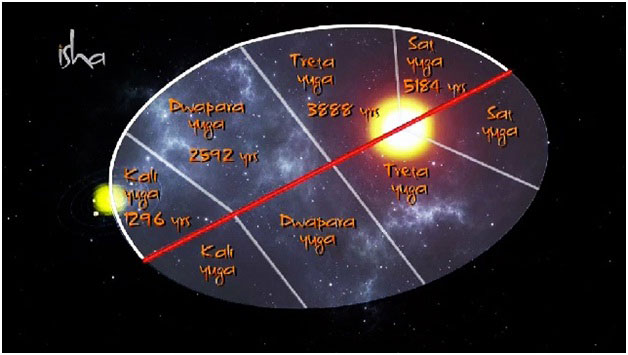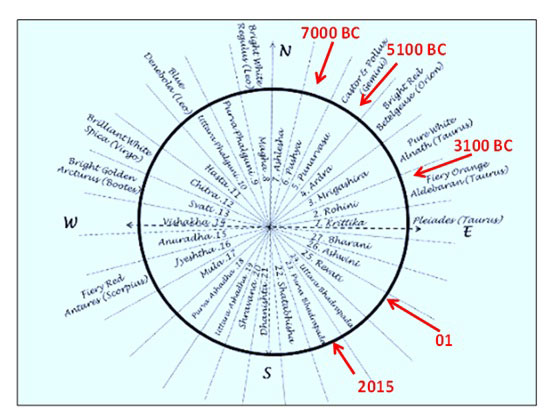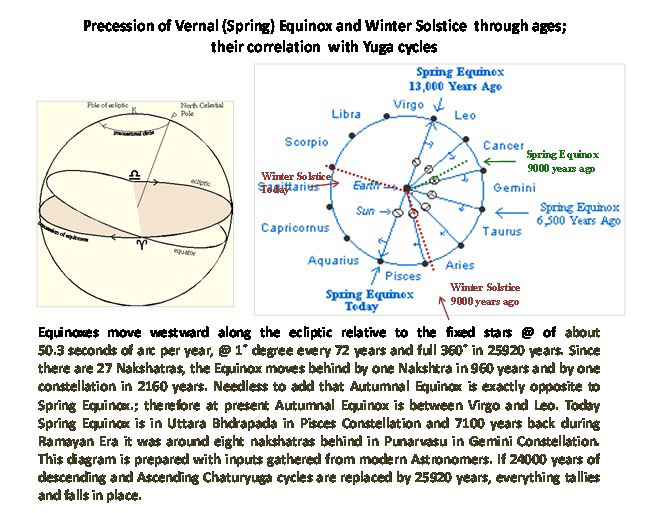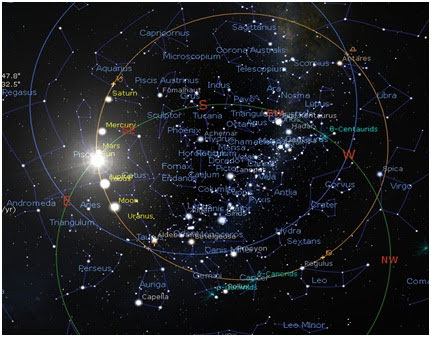An extract from my interview with News NCR channel about my Ramayan Books
April 28, 2019Mahabharat Retold with Scientific Evidence
March 23, 2021Concept of Yugas Re-examined: Interpretations and Clarifications
Description of Chaturyuga in Human years as well as in Divine years as per Manusmriti; 1/65-71 (Manusmriti, Desdhpandey) is summarized hereunder –
|
Yuga
|
Main period |
Sandhya + Sandhyansh |
Total Length |
Multiply by 360 as one divine yr = 360 human yrs |
|
Krit-yuga |
4000 |
400 + 400 |
4800yrs |
17,28,000 |
|
Treta-yuga |
3000 |
300 + 300 |
3600yrs |
12,96,000 |
|
Dvapara-yuga |
2000 |
200 + 200 |
2400yrs |
8,64,000 |
|
Kali-yuga |
1000 |
100 + 100 |
1200yrs |
4,32,000 |
|
Total |
10,000 |
2000 |
12,000 yrs |
43,20,000 yrs. |
Many ancient as well modern scientists and scholars believe that originally Chaturyuga (Satyuga + Treta + Dwapar + Kaliyuga) was of 12000 human years only and that also in descending and ascending order with some more years in between. However, sometime in the remote past, it was misinterpreted as Chaturyuga of divine years. By taking one year of humans as equal to one day of gods (devas), these 12000 years were multiplied by 360 (180 days of northward movement + 180 days of the southward movement of the Sun). As a result, the Chaturyuga of human years was taken at 43,20,000 years (12000*360 = 43,20,000 years). What could be the justification for applying ‘divine year’ to the humans and that also by multiplying Human Chaturyuga of 12000 years with the number of days of the northward and southward movement of the Sun?
I looked into Manusmriti to find the answer. In verses 65, 67, 69-71 of Chapter 1 of Manusmriti, the description of Chaturyuga is as under–
“65. The Sun divided the day and night of the devas (gods) and Men. The night is for the sleep of creatures, and the day is for the performance of works/duties.
67. One full year of men makes one day and one night of the gods. The northward movement of the Sun (Uttarayan) is their day, and Southward movement (Dakshinayan) is their night.
69. The KritaYuga (Satyuga) consists of four thousand years; four hundred such years form the Sandhya and four hundred such years form the Sandhyansh.
70. Of the remaining three yugas, the duration of each succeeding Yuga is less than those of its predecessor by one thousand; it’s Sandhya and Sandhyansh, are respectively less by one hundred years each; thus making the difference of twelve hundred years.
71. Twelve thousand years of such four yugas, as computed before in their order of enumeration, count as one yuga of the devas, i.e. gods.
(Very similar verses are also available in chapters 11-13 of 3rd Skandh of Srimad Bhagvada Mahapurana)
The use of expression, ‘day and night of gods’ in 1/67, considering 180 days of Northward movement of the Sun as their day and 180 days of Southward progression of the Sun as their night, in some remote past was probably interpreted in the manner that these 360 days make one day and night of gods. Therefore, 360 human years were considered as equal to one divine year of gods. Consequently, by multiplying these 12000 divine years of Chaturyuga with 360, the duration of Chaturyuga was taken as 43,20,000 human years.
However, since the most ancient times, many scholars and scientists have disagreed with this interpretation. Nevertheless it has been followed over the years without review/application of mind. More than 2500 years back eminent Sanskrit sage and scholar, Medhatithi had considered this an error and had put the duration of Chaturyuga at 12000 human years only. During the last sixty years, several scholars, sages and scientists have also held this view. JaggiVasdevJi, Swami Sri YukteswarGiri, PanditBhagwadduttSatyashrava, Shri K M Ganguli, Shri Richard Thompson and many others, have written books and articles and have delivered lectures explaining with credible justification this view of Yuga cycles.
Therefore, a Chaturyuga may indeed comprise only of 12000 years. Besides, there have to be descending and ascending cycles of Chaturyuga, with some more years in between. This takes us to the completion of the precession cycle by Earth in 25920 years, which is accepted by modern Astronomy! Even Glaciology supports this view and holds that this might be the seventh such Yuga cycle (seventh Manvantra?) going on.
Hon’bleJaggiVasdevJi has explained the cycle of four Yugas saying, “The precession, caused by gradual rotation of the Earth’s axis, of the equinoxes is the time that it takes the Earth’s axis to pass through one complete cycle of the zodiac. It takes the planet 72 years to pass through one degree of the zodiac and 25,920 years to complete one full circle of 360 degrees. One half of the journey takes 12,960 years and covers the four Yugas. Satya Yuga lasts 5184 years. Treta Yuga lasts for 3888 years. Dwapara Yuga lasts 2592 years. Kali Yuga lasts 1296 years. These four yugas taken together come to a total of 12,960 years.” Descending and Ascending cycles of Chaturyugas complete a cycle of 25920 years. (Sadhguru 2003) SadhguruJaggiVasudev also relates these descending and ascending sequences of Chaturyugas to downward and upward movement of human consciousness. The good news is that he believes that currently, it is Dvapara Yuga and not Kali Yuga, and that also in its ascending phase. Hon’bleJaggiVasdevJi has explained this Yuga cycle connecting it with one complete cycle of precession of Equinoxes by way of the following image –
Pic. 56: Yuga cycle and precession of Equinoxes explained by JaggiVasudevJi
The solar system, with the Sun and the planets around it, is moving in the galaxy. It takes 25,920 years for our solar system to complete one cycle around a more massive star. Sadhguru has also explained that this big star/big system, around which our solar system is going, is not located in the centre of the orbit. Whenever, our solar system comes closer to this big star, all the creatures living on planet earth rise to greater possibilities. On the other hand when our system moves away from it, the creatures living in our system come to the lowest level of potential. Whenever our solar system is closer to the “Super Sun,” Satya Yuga will begin. The human mind will then be at its highest capability. People’s ability to know life, people’s ability to communicate, people’s ability to live joyfully will be at its highest.
Swami Sri YukteswarGiri has explained the 12000 years of descending and 12000 years of ascending Chaturyuga cycles by correlating the precession of Equinox with the mental virtues of the inner world (The Holy Science). He has explained that the Sun also revolves around a grand centre called Vishnunabhi, which is the seat of creative power known as Brahma, the universal magnetism. When the Sun comes nearest to the Vishnunabhi, which event takes place when Autumnal Equinox comes to the first point in Aries, the mental virtues are the most developed; therefore, that would be Sat Yuga. When Sun goes to the farthest point, it is Kaliyuga. As per Sri YukteswarGiri, Autumnal Equinox was in the first point of Aries around 11501 BCE; thus, the human intellect was at its best at that time, and after that, it began to diminish. Therefore, by the end of descending Kali Yuga in around 499 CE (11501 – 12000), it was at its lowest. Thereafter, there were 1200 years of ascending Kali Yuga and currently it is Dwaparayuga going on.
The precession cycle of Vernal Equinox during last 25920 years
If we look at the principles of modern astronomy, these 12000 years of descending and ascending Chaturyuga cycles have to be replaced by 12960 years each. Twenty-four thousand years of Descending and Ascending Yuga cycles are to be replaced by 25920 years. The length of a year is to be taken of 365 days, 5 hours, 48 minutes and 46 seconds, instead of 360 days. Sandhya or Sandhyansh are meant to give flexibility to the number of years falling under each Yuga. Some indefinite number of years pass in between the descending and ascending cycles of Kali Yuga.
Eminent Historian PanditBhagwadduttSatyashrava has recorded in his book titled ‘BharatvarshkaBrihadItihas’ that the Era of Lord Ram was in the Sandhi period of Treta and Dwapara and this could be around 5200 years before the beginning of VikramSamvat. He has also added that Shri Krishna was born towards the end of Dwapara whereas Kali Era started after his departure for the Heaven. This was around 3200 years before VikramSamvat, thus giving a gap of just about 2000 years between Ramayan and Mahabharat Eras. Shri Satyashrava had emphatically added that “Treta and Dwapara Eras certainly did not consist of lakhs of years” (Satyashrava 2000, 7th chapter, page 163). Shri Satyashrava also expressed the opinion that in ancient Sanskrit wherever the word sahasrani has been added to the number of years it normally means approximately (BharatvarshkaBrihadItihas’ part 2, chapter 11, page 580. He has also given a very different explanation for the elucidation of the gap between descending and ascending cycle of Chaturyugas, which aims at explaining the meaning of Devyuga alias Divyayuga and also aims at reconciling cycle of 24000 years with 25920 years. He has referred to the extracts from the text of Ramayan and Mahabharat, wherein reference has been made to Devyuga prevailing prior to Krityuga. He has also said that there could be some extra years between Descending and Ascending cycles. It needs to be noted that the dating of astronomical references in Ramayan and Mahabharat, done by making use of planetarium softwares, has proved his assertions correct. The astronomical dates of Ramayan relate the Epic to 5100 BCE, whereas the astronomical dates of Mahabharat relate the events narrated therein to 3100 BCE; a time gap of 2000 years (Satyashrava 2000, 7th chapter, shri Krishna was born in dwapar and kali kisandhi, page 163).
It needs to be taken note of that in all these ancient time-reckoning calculations length of a year was taken as 360 days whereas actually, it is 365 days, 5 hours, 48 minutes and 46 seconds. This difference in the length of the year would also require adjustment in the span of Yugas. Further, if we accept the Chaturyuga cycle of 43,20,000 years, then are we prepared to declare that Kali Yuga consists of 4,32,000 years, of which 4,27,000 are still left? Are we able to explain what happened during those 9,27,000 years, which would be the time gap between the eras of Shri Ram, who is said to have lived in TretaYug, and of Shri Krishan, who lived at the end of Dwaparayuga?
We, therefore, make a very humble request to the sages and scholars to review the traditional interpretation of Chaturyuga and bring back Ramayan and Mahabharat from the realm of mythology to the domain of history, to which they in reality belong. Only after that, we shall be able to make a rightful claim that India’s civilization is the oldest in the world during the current Holocene period and that Aryans were the originals of India who have been developing indigenous Vedic Civilization for thousands of years.
Aryabhata had determined the beginning of the Kali era on 19th February, 3012 BCE (Aryabhatia; Gitikapada – 5 &Kalakriyapada – 10). He had written that 3600 years of Kali-era had elapsed when he completed writing the book at the age of 23.
According to the Surya Sidhanta, Kali Yuga began at midnight (00:00) on 18th February 3102 BCE. According to the astronomer and mathematician Aryabhata, the Kali Yuga started in 3102 BCE. He finished his book Aryabhattiyam in 499 CE, in which he gives the exact year of the beginning of Kali Yuga. He writes that he wrote the book in the “year 3600 of the Kali Age” at the age of 23. As it was the 3600th year of the Kali Age when he was 23 years old, and given that Aryabhata was born in 476 CE, the beginning of the Kali Yuga would come to (3600 – (476 + 23) + 1 (As only one year elapses between 1 BCE and 1 CE)) = 3102 BCE. (sarojbala.blogspot.in). According to Saha and Lahiri (1955), the beginning of the Kali era in 3102 BCE, is based on the assumption that the grand conjunction of the Sun, the Moon and other five planets was seen at the starting point of Aries. This grand conjunction has actually been displayed by modern-day Stellarium software on 18th -19th February 3101 BCE (3102 BCE historical year), thus confirming the traditional belief.
Delhi, India (28.70°N, 77.20°E). All seven planets at the entry point of Aries (Mesha) displaying Famous Kali Era Conjunction on 19th February 3101 BCE at 7.20 AM (Stellarium Sky shot); Astronomical date 19th February 3101 and Historical date 19th February 3102
It is therefore earnestly requested that our sages, scholars, and scientists make this much-needed correction in the concept of Chaturyuga cycles so that 12000 human years, described in our ancient texts, are not multiplied by 360 days of the northward and southward movement of the Sun. As a result, the length of the Chatur Yuga would not be taken as 43,20,000!




